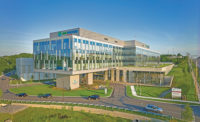Global Best Projects 2019
Project of the Year Finalist, Health Care: Ankara Bilkent City Hospital

Completed complex opened two-bed rooms in March, only four years after design began.
PHOTOS COURTESY CCN ALTYAPI YAIRIMLARI VE INSAAT A.S.

Completed complex opened two-bed rooms in March, only four years after design began.

Completed complex opened two-bed rooms in March, only four years after design began.

President Erdogan’s government was able to open the new hospital on time despite opposition to the P3 delivery approach.

President Erdogan’s government was able to open the new hospital on time despite opposition to the P3 delivery approach.





Ankara Bilkent City Hospital
Ankara, Turkey
Best Project
Owner Ministry of Health of Turkey
Design Firm N.K.Y Mimarlik
Contractor CCN Altyapi Yatirimlari ve İnşaat A.S.
Civil Engineer Hidrolink Mühendislik
Structural Engineer Bensum Mühendislik
MEP Engineer GMD Mühendislik
Consultant Dorsky + Yue International
Turkish President Recep Tayyip Erdogan’s medical megaproject, the Ankara Bilkent City Hospital, opened for business in the first quarter of 2019. The 1.3-million-sq-meter hospital has 3,700 beds. At a cost of about $1 billion, according to press reports, the hospital is Europe’s largest health complex. (Turkey is in both Asia and Europe.)
Since 2017, Turkey has opened hospitals in eight other cities. Nine more are under construction. The hospital construction program’s goal is to provide more than 44,000 beds and offer a centralized approach to all types of treatment, including cardiovascular disease, obstetrics and gynecology, oncology, neuroscience and childhood diseases. A core structure connects to six hospitals in the different specialties and a ring road connects perimeter hospitals to support facilities. A pneumatic tube system conveys sample tubes collected in medical examinations to the central lab. The fully automated system aims at rapid turnaround.
Beyond its size, the hospital exemplifies the government health ministry’s attempt to upgrade Turkey’s overall quality of health care. Government supporters cast the project as a paradigm of modernization in medical services delivery and efficiency, pointing out that the public-private partnership (P3) project delivery enabled design and construction to finish in four years. On Bloomberg’s 2019 Healthiest Country Index, Turkey ranked No. 51, up three places from its spot in the 2017 survey.
Turkey had no legal/contractual framework for P3s, but the Ministry of Health put one together with an international cast. Law firms and technical consultants crafted an EPC contract that satisfied conditions set by lenders from Turkey, Russia, Italy and Germany. The P3 package stood up despite Turkey’s 2018 currency and debt crisis and sustained the work until the project was completed. During that time, the construction and project management teams had to overcome the uncertainty the crisis triggered among suppliers and subcontracting teams.
The project also had to survive much criticism. During discussions earlier in this decade to amend Turkish law and make P3s possible, trade unions and the Turkish Medical Association were left out of the conversation. The TMA, which is both a professional association and a trade union for doctors, pushed back. It pointed out what it saw as numerous issues with the P3 approach, including a flawed and nontransparent selection process. Irregularities also plagued the tendering process, TMA maintained. The association pointed to the trend against megahospitals and toward smaller facilities, and it cited academic studies that show a hospital’s efficiency declines when the number of beds exceeds 600.
The complex fulfills a key part of the Erdogan government’s dream of modernizing a decrepit public health care system. It replaces the six aging existing treatment facilities—one over a century old—with a state-of-the-art full-service hospital. Much coordination was needed to get to the finish line.
The project involved more than 5,000 companies, with a work force surpassing 8,000 at peak, supported by more than 1,500 administrative personnel. Extensive communication and coordination was needed between design teams and the head physicians of the six hospitals being absorbed, as well as the P3 department in the Ministry of Health.
The construction team managed a diverse labor force and a supply chain that stretched from Turkey to Germany, Italy, Switzerland and the U.K.
Construction materials included 900,000 cu m of concrete, 2.3 million sq m of formwork, 2.6 cu m of earthwork and fill and 1.2 million sq m of wall partitions. The mechanical component of the complex provided its own challenge, with 16.5 million m of cabling.
The health, safety and environmental (HSE) assurance unit conducted extensive training and monitoring exercises with training sessions that accounted for more than 1.2 million worker-hours of HSE training. The effort generated a recordable accident rate of 0.0498.
At the Ankara Bilkent City Hospital opening ceremony, President Erdogan challenged his critics head on. He said that the same people who “oppose bridges, highways, tunnels, airports, highways, hospitals and schools” are “the ones using them.” If Erdogan and Turkey’s medical professionals can settle their differences and capitalize on the new health care complex in Ankara, the dream of improved health care for Turkey will be several steps closer to becoming a reality.










